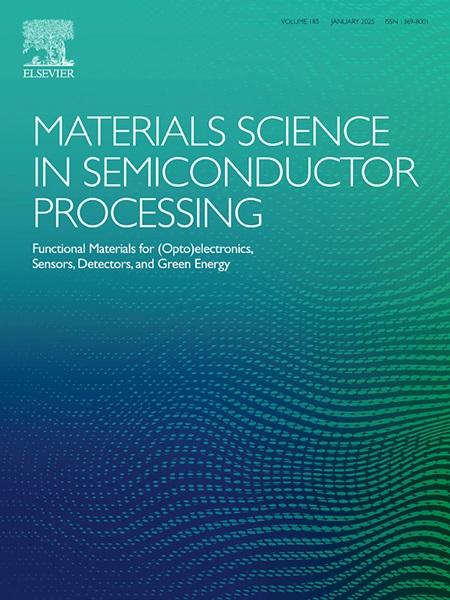Organic memristor based on graphene oxide quantum dots: PEDOT-PSS composite film
IF 4.2
3区 工程技术
Q2 ENGINEERING, ELECTRICAL & ELECTRONIC
引用次数: 0
Abstract
The two-terminal memristor, characterized by their low power consumption, tunable resistance, simple structure, and compatibility with CMOS processes, have found applications in memory storage, logic circuits, and synaptic functions of the simulated human brain. Graphene oxide quantum dots (GO-QDs), a zero-dimensional nanocarbon material, are noted for their low cost and eco-friendliness, making them suitable for electrocatalysis and the fabrication of various optoelectronic devices such as batteries, supercapacitors, and light-emitting diodes. In this paper, we report a two-terminal memristor based on GO-QDs doped with poly(3,4-ethylenedioxythiophene)-poly(styrenesulfonate) (PEDOT-PSS). Through systematic optimization of our experimental protocol, we found that a doping concentration of 60 % resulted in optimal device performance, achieving an ON/OFF current ratio (Ion/off) up to 104 and retention capability lasting up to 104 s. Through the analysis of the optoelectronic properties of the films, fitting of the I-V characteristics, and electrochemical impedance spectroscopy (EIS) tests, we confirmed that the resistive switching mechanism is the trapping and detrapping process of charge traps induced by PEDOT-PSS or GO-QDs.
氧化石墨烯量子点有机忆阻器:PEDOT-PSS复合膜
该双端忆阻器具有功耗低、电阻可调、结构简单、与CMOS工艺兼容等特点,在模拟人脑的记忆存储、逻辑电路、突触功能等方面具有广泛的应用前景。氧化石墨烯量子点(GO-QDs)是一种零维纳米碳材料,以其低成本和生态友好性而闻名,适用于电催化和制造各种光电子器件,如电池、超级电容器和发光二极管。在本文中,我们报道了一种基于掺杂聚(3,4-乙烯二氧噻吩)-聚苯乙烯磺酸盐(PEDOT-PSS)的氧化石墨烯量子点的双端记忆电阻器。通过对实验方案的系统优化,我们发现60%的掺杂浓度可以获得最佳的器件性能,实现高达104的ON/OFF电流比(Ion/ OFF)和长达104 s的保持能力。通过对薄膜的光电特性分析、I-V特性拟合和电化学阻抗谱(EIS)测试,我们证实了电阻开关机制是PEDOT-PSS或GO-QDs诱导的电荷陷阱的捕获和去捕获过程。
本文章由计算机程序翻译,如有差异,请以英文原文为准。
求助全文
约1分钟内获得全文
求助全文
来源期刊

Materials Science in Semiconductor Processing
工程技术-材料科学:综合
CiteScore
8.00
自引率
4.90%
发文量
780
审稿时长
42 days
期刊介绍:
Materials Science in Semiconductor Processing provides a unique forum for the discussion of novel processing, applications and theoretical studies of functional materials and devices for (opto)electronics, sensors, detectors, biotechnology and green energy.
Each issue will aim to provide a snapshot of current insights, new achievements, breakthroughs and future trends in such diverse fields as microelectronics, energy conversion and storage, communications, biotechnology, (photo)catalysis, nano- and thin-film technology, hybrid and composite materials, chemical processing, vapor-phase deposition, device fabrication, and modelling, which are the backbone of advanced semiconductor processing and applications.
Coverage will include: advanced lithography for submicron devices; etching and related topics; ion implantation; damage evolution and related issues; plasma and thermal CVD; rapid thermal processing; advanced metallization and interconnect schemes; thin dielectric layers, oxidation; sol-gel processing; chemical bath and (electro)chemical deposition; compound semiconductor processing; new non-oxide materials and their applications; (macro)molecular and hybrid materials; molecular dynamics, ab-initio methods, Monte Carlo, etc.; new materials and processes for discrete and integrated circuits; magnetic materials and spintronics; heterostructures and quantum devices; engineering of the electrical and optical properties of semiconductors; crystal growth mechanisms; reliability, defect density, intrinsic impurities and defects.
 求助内容:
求助内容: 应助结果提醒方式:
应助结果提醒方式:


